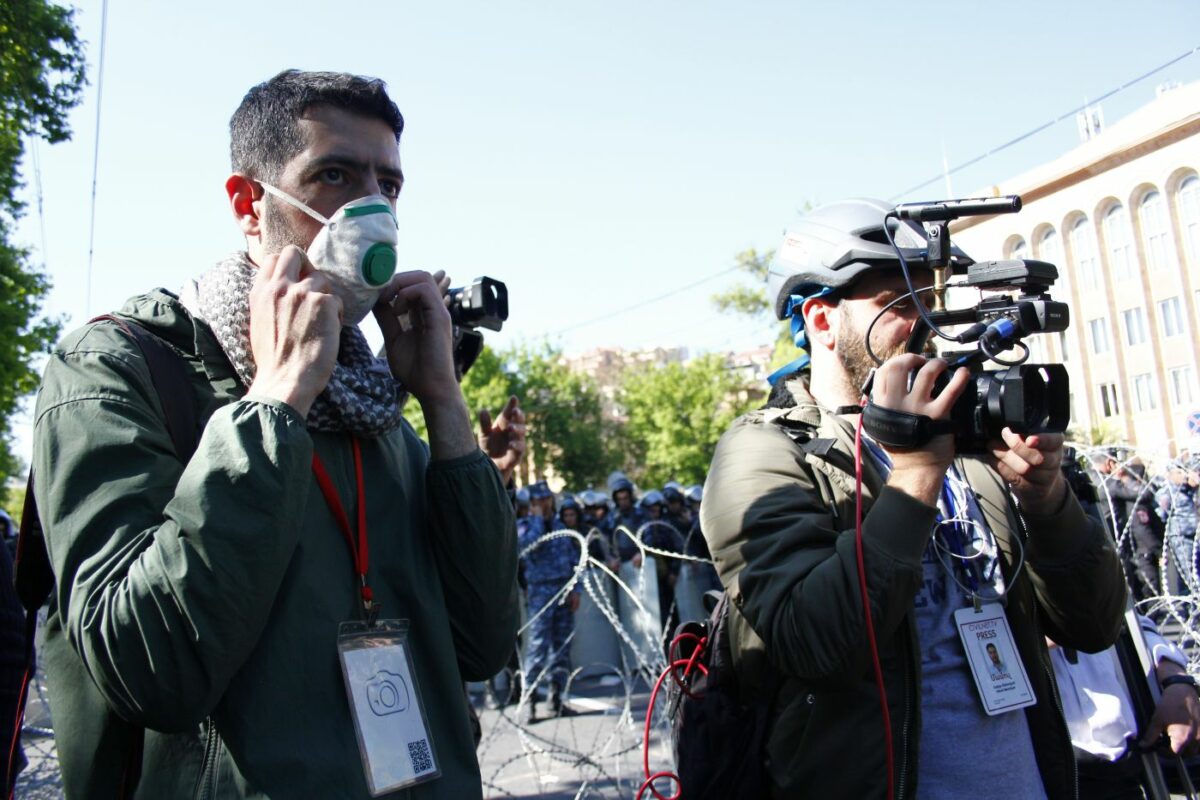
Journalists, photographers and cameramen have been prepared since early morning to cover the process of the #MyStep protest campaign, which had been developing across different points in Yerevan, accompanied by the blockades of streets and bridges. Later, as we saw, the scene of the campaign was constantly changing. Students and police officers were mobilizing, and clashes took place.
Journalists were forced to take into account events which were taking place at different hot spots and work in a state of emergency.
The #MyStep campaign was started by the Civil Contract political party. The goal of the campaign is to prevent a third term of Serzh Sargsyan in office, as the Prime Minister.
Starting from Gyumri, over the course of 14 days, participants trekked a road of over 200 km, reaching Yerevan’s Freedom square on April 13.
The focal point of the campaign was on April 16, when the number of protesters grew to a couple thousand, coming face to face with a wall of police officers on Baghramyan Avenue.
We have summed up the first part of April 16 with journalists and highlighted the good and bad sides of the work process.
Aida Karapetyan, AR TV

From morning until presently, we have four teams working from our television company. Minutes later, there will be reports in our news outlets.
Our teams were working in different parts of the city, in order to show the full picture of the situation. Overall, the working process has been easy so far and there have been no obstacles.
Knar Khudoyan, iLur.am

In my opinion, at this moment not only journalists, but also participants are not determined in their actions, and it’s very important that aside from online media coverage, we understand the logic behind the steps that the organizers take, the scenarios of police action etc. Only after that should we cover the events taking place on the scene.
Since morning it has been impossible to go to Baghramyan Avenue, it was closed down, and it is not clear if we should go in that direction or not. We as journalists need to understand, and inform our audience
Tirayr Muradyan, Union of Informed Citizen
 #MysStep is a new format of working for journalists, because you can’t work in one place, you need to constantly move around and carefully record the events that are taking place.
#MysStep is a new format of working for journalists, because you can’t work in one place, you need to constantly move around and carefully record the events that are taking place.
This unpredictability also inspires journalists. For example, in the morning we knew that they were going to close the bridges, so we went there, however, the plans later changed. That is, we also didn’t know, what was going to happen in the next moment. Meanwhile elsewhere, we followed the developments at Heratsi street, they closed the street.
In my work experience I have never experienced this amount of adrenaline when reporting on protests and other campaigns.
Ani Gevorgyan, photographer, Forrights.am

In such situations it’s very important to work with your badge on you, however my experience has shown, that police officers nonetheless do not spare journalists either. That fact is scary.
I am covering the march as a freelance journalist, especially focusing on how many involved in the campaign are young people and students. The thematic approach makes my work more interesting, as I am able to further narrow and deepen the core of my photos.
Gevorg Tosunyan, CivilNet.am

#MyStep is the first protest campaign where the people have spontaneously united, and it is something new for journalists as well. It is inspiring. You even begin to work more enthusiastically.
During the demonstration I noticed some police officers in civilian clothing, I went up to them so that I could take an interview and understand what they were doing, however they were adequate and didn’t argue. The police also behaved adequately towards journalists, I haven’t noticed any clashes between journalists and police officers this week.
Shoghik Galstyan, Factor.am

In the space between Heratsi street and Koryun street there was a scuffle, they didn’t look at the journalists’ badges and they turned them into targets as well. At that point, a few journalists (Hraparak, CivilNet.am) found themselves in front of a wall of police officers.
During that time, I quickly surpassed them and started working from the side. It is important as a journalist to stay one step ahead and if necessary, be able to protect yourself and continue the coverage.
The police don’t listen to you, even if you are shouting loudly that you are a journalist. They don’t spare journalists, and they don’t listen.
Tatev Khachatryan, Armenian Time

The difficulty is that reporters aren’t able to be at the hottest spots of disobedience all at the same time. We have correspondents all over the place, and we try to cover the story in an operative way, however the media agencies that win, are those who manage to provide a livestream connection.
Sometimes that also prevents people from coming and joining the protests. If it were not for the live broadcasts, people would go into the streets, if only to see and understand what is going on. In general, for journalists it is a peaceful and unobstructed protest. At least for now.
Lilian Galstyan, photographer, Panorama.am

In the morning on Heratsi street, when the black car drove towards the people, I barely managed to escape being run over. You don’t know who is at the wheel, what goal they have and what they will do to you. That was the only dangerous moment.
Since the campaign plans were rapidly changing, and there was a lot of action, it meant that once in a while we had to empty our storage and be ready for the unpredictable.
Gayane Asryan
Photos by Gagik Aghbalyan


Add new comment
Comments by Media.am readers become public after moderation. We urge our readers not to leave anonymous comments. It’s always nice to know with whom one is speaking.
We do not publish comments that contain profanities, non-normative lexicon, personal attacks or threats. We do not publish comments that spread hate.